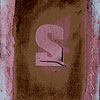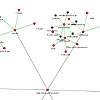 Originally
published
on
07/20/03
Originally
published
on
07/20/03Processing - new work on flight404.com
webcam:landscape
webcam:sonic
webcam:fireflies
Processing represents the most dramatic shift in work on Robert Hodgin's 'digital playground' flight404.com since its inception three years ago. Alongside pieces like 'ribbon' inspired by Yugo Nakamura (yugop.com), version 6 of the site features new generative work that experiments with real-time webcam filtering. Complex algorithms interpret video feed, color tracking and audio input to create exquisite environments and video imagery.
:: Neil Jenkins ::
 Originally
published
on
07/23/03
Originally
published
on
07/23/03
Walter
Benjamin
is
best
known
for
his
essay
"The
Work
of
Art
in
the
Age
of
Mechanical
Reproduction."
Benjamin's
most
polemic
statement
is
on
the
aura
(uniqueness/cultural
specificity)
of
the
work
of
art,
which,
according
to
him,
withers
away
when
the
object
is
mechanically
reproduced.
The
aura
of
the
work
of
art
was
more
recently
reconsidered
by
Douglas
Davis
in
his
online
essay
"The
Work
of
Art
in
the
Age
of
Digital
Reproduction."
Here,
the
death
of
the
aura
is
again
revisited,
not
in
relation
to
objects,
but
in
relation
to
information
networks.
And
then
along
comes
an
artist...
Arcangel
Constantini
has
developed
the
online
project
The
Work
of
Art
in
the
Age
of
Mechanical
vs.
Digital
Reproduction;
which,
in
a
way,
reconsiders
ideas
in
both
of
the
aforementioned
essays
(although
he
does
not
reference
either
writer
directly).
Constantini's
project
presents
computer
manipulated
reproductions
of
serigraph
prints;
each
reproduction
is
available
for
purchase
only
during
the
moment
of
presentation.
The
user
can
purchase
the
moment
for
whatever
amount
desired.
Once
the
window
is
closed,
the
object
only
exists
in
the
collector's
memory.
A
record
of
all
virtual
collectors
is
also
kept
in
the
website's
database.
Constantini
is
interested
in
the
tension
between
concrete
and
digital
space.
He
questions
whether
"In
concrete
space…there
[is]
such
a
thing
as
a
copy,
or
is
each
reproduction
an
original?
In
virtual
space,
is
the
original
the
code
and
the
copy
the
interpretation
of
such
code?"
These
and
other
questions
haunted
Constantini
while
developing
Mechanical
vs.
Digital.
And
the
result
is
an
intriguing
piece
of
online
art,
which
exposes
the
current
roles
of
the
work
of
art
as
an
object
of
contemplation,
a
marketable
item,
a
form
of
communication,
and
a
critique
of
its
supporting
culture.
The
Work
of
Art
in
the
Age
of
Mechanical
vs.
Digital
Reproduction
effectively
shows
that
the
work
of
art
is
now
completely
dependent
on
its
context
for
use
value,
which
means
that
contextualization
may
be
taking
over
where
the
aura
left
off[1].
There
may
no
longer
be
an
original
work
of
art,
but
there
will
always
be
original
and
unique
experiences
--
and
this,
Constantini's
work
is
able
to
bring
to
netizens
all
around
the
internet.
[1]
It
should
be
made
clear
that
context
has
always
been
part
of
a
work's
contemplation.
The
difference,
as
Benjamin
himself
points
out
in
his
famous
essay
is
that
now
critical
minds
can
no
longer
assume
a
suspension
of
context
as
a
given.
One
must
keep
in
mind
under
what
conditions
was
the
object
originally
produced
and
reproduced.
::
Eduardo
Navas
::
 Originally
published
on
07/22/03
Originally
published
on
07/22/03This review for Valérie Lamontagne's new project "Sister Valérie of the Internet" came to me in the last few days via the "noemalab" mailing list and struck me as being both unique and linked to Tamara Laï's recent call for contributions to her "portrait of god" project. (see that? cross referencing!).
It's not often you see two net-art pieces on the subject of religion in the same week. Granted, they both take very different approaches. Tamara Laï's questions whether new spaces require new religions while Valérie Lamontagne's takes advantage of the bizarre online cultural phenomenon of people wanting to write about every little detail of their lives. Two artists (ironically both French speaking artists) 'using' religion in unique and interesting ways and in such a would-be godless place questions whether net art is gradually moving away from the cold inhuman style it is so often accused of having and suggests that even in new places we can never escape ourselves or our culture.
Valérie Lamontagne's "Sister Valérie of the Internet", a net-performance allowing users to confess their sins online, is the chosen "Splash Page Project" for the months of July/August on "Year Zero One". Further information, dates and times for the performance can be seen on the "Year Zero One" page or the "Sister Valérie of the Internet" project page. So, go redeem yourself!
:: Garrett Lynch ::
 Originally
published
on
07/20/03
Originally
published
on
07/20/03Maps / graphing applications of the internet have existed almost as long as the Internet itself. Originally being created only in the domain of scientists and programmers, for a few years now, net artists have been making attempts of their own to understand the structure of the space they work in.
"Flexplorer" is the latest example of such attempts by erational.org created in flash. Not without its problems (like all internet mapping systems, due to the huge task of such an undertaking), "Flexplorer" is a valid research towards an understanding of how we tend to visualize information structures on computers by using visual clues of things around us: the stem, head and petals of a flower, the spiraling outward growth of a snails shell, etc. All of the above are examples of sophistication from a central starting point and this is what "Flexplorer" does. It starts with a point on the network, a URL, and a webpage; and then spiders out via links on that page to create an ever increasing complex structure.
For me, "Flexplorer" lacks a certain artistic touch that would make it a unique vision of the network. Little is done to take it much further than I/O/D's "Web Stalker" in how it displays the webpage and its locality. In fact, it could be said that the visualization is what we have come to expect in those few years that we have been using the network and have been barraged by images of complex structures of information via popular culture. That said, this is version 1.0 of "Flexplorer" and so this is most probably one to watch out for in the future!
:: Garrett Lynch ::